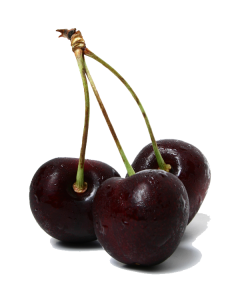Chock Full of Cherries

Geri Wohl, CNC
Better Eating Coach
Written By: Geri Wohl, CNC
www.bettereatingcoach.com
Memorial Day has just passed and summer is around the corner which means that we are in the beginning of cherry season. Since cherry season is short, be sure to take full advantage of the small window of purchasing the freshest and sweetest of these little gems.
Cherries date back to 300 BCE, and likely originated in an ancient Turkish town called Cerasus. They arrived in America with our earlier settlers in the 1600s. Cherries are known as drupes; they are fruit with a thin skin, fleshy pulp and a stone containing the seed. Cherries are part of the rose family, which also contains apricots, plums and peaches. There are two primary types of cherries grown—sweet or sour. Sweet cherries, the most noted of which are Bing, come in more than 500 varieties and have enough innate sugar that eating them raw is a favorite sweet treat. In the US, about 85% of sweet cherries are grown in Washington, Oregon and California. Sour cherries are too tart for most of us to eat raw. They are typically used in pies or sauces. The majority of US-grown sour cherries are produced in Michigan.
Both types of cherries have more innate sugar than many other fruits. Keep the sugar content in mind when choosing what fruit to consume. While not significant, sweet cherries are higher in calories than sour due to their increased sugar content. For example, one cup of sweet cherries has 87 calories compared to 77 calories for sour cherries. This difference in sugar amount may be moot, as most sour cherries will be used in recipes that call for added sugars. Another significant difference is that sour cherries are loaded with vitamin A—they have a whopping 2000 IU in a cup versus sweet cherries that have just under 100 IU per cup. Vitamin A supports our vision, skin health, immune system and red blood cell production. Both types of cherries are very good sources of vitamin C, copper and manganese. In addition, the antioxidants in cherries make them a “go to” food for certain conditions.
The darker the color of the fruit, the more antioxidants it possesses. So the deep purple color of Bing cherries is an indication of its powerful antioxidants, specifically the flavonoids. Antioxidants help the body repair damage done by free radicals that may be generated during metabolic processes or from environmental sources. For more about antioxidants, see my article, “Spice It Up“. Let’s look at some of the benefits we may obtain by adding cherries into our diet.
 Gout is a form of arthritis that occurs when the body accumulates excess uric acid in the blood causing inflammation and swelling. Cherries (both types) and cherry juice have been used to relieve gout symptoms. In fact, a Boston University study showed that consuming ½ cup of cherries (about 10-12 cherries) for just two days resulted in a 35% lower risk of a gout attack.
Gout is a form of arthritis that occurs when the body accumulates excess uric acid in the blood causing inflammation and swelling. Cherries (both types) and cherry juice have been used to relieve gout symptoms. In fact, a Boston University study showed that consuming ½ cup of cherries (about 10-12 cherries) for just two days resulted in a 35% lower risk of a gout attack.- Tart cherries are a natural source of melatonin, the hormone that helps the body regulate its circadian rhythms (sleep and awake cycles). Two tablespoons of tart cherry juice have been shown to be as effective as a melatonin supplement. How exciting that you can have a natural sleep aid right in your refrigerator!
- Both types of cherries are loaded with potassium, which is a natural blood pressure reducer. Potassium works by offsetting salt and regulating the body fluids. As a reference point, one cup of cherries is about equivalent in potassium content as one small banana. In addition, cherries also contain quercitin that supports the blood vessels by allowing them to be more relaxed and elastic. For more about salt content in food, see my article, “Eating Well to Lose Weight: Look At the Label“. Note that excess sodium or potassium can present problems. Of course, if you have high blood pressure, consult with your physician before making any dietary changes.
- Tart cherries may also relieve exercise-induced pain. The antioxidants found in these cherries may be protecting the muscles from damage as well as exerting an anti-inflammatory response.
- Osteoarthritis has also shown improvement with both sweet and tart cherry intake. The anthocyanins, responsible for the deep purple color, are antioxidants that can relieve inflammation by affecting the same pathways used by ibuprofen and naproxen without any adverse stomach effects. A lowering of the anti-inflammatory blood markers was used to validate the anti-inflammatory properties of cherries.
- The unique composition of antioxidants in cherries has been studied for their anti-cancer properties. The anthocyanins, beta-carotene (found in sweet cherries), vitamin C and quercitin may act synergistically to help fight cancer cells that have formed in the body.
Pick your cherries with care. Cherries should have bright and glossy skin. The darker the skin, the more health benefits you obtain. The fruit should have a little give and not be too hard. Cherries will not ripen after picking so choose cherries that look ready to eat. Place unwashed cherries loosely in a plastic bag to minimize any damage. Refrigerate for up to a week.
Enjoy these summertime treats by picking them up at Sigona’s Farmers Market and reap their powerful benefits! Sigona’s also has plenty of cherry recipes for you to try out in their post, “Cherry-licious Recipes“.
© Geri Wohl, CNC









